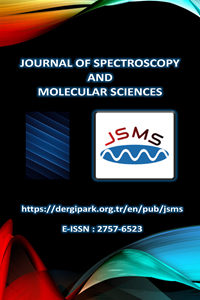Alitame hesapsal Raman spektrumu
Alitame yapay bir tatlandırıcıdır ve diğer birçok tatlandırıcı gibi yiyecek ve içeceklerde tatlı bir tat vermek için kullanılır. Bu tatlandırıcılar moleküler yapılarına ve işlevlerine göre farklı tatlılık skalası sergilerler. Ayrıca birçok yapay tatlandırıcının çok detaylı titreşim spektrumları olmadığı için hem deneysel hem de hesaplamalı verilerin elde edilmesi ve bu tür bileşikler üzerinde toplanmasına ihtiyaç vardır. Bu çalışmada, Raman spektrumları Gaussian09 yazılımı ile DFT/6-311 ++ G(2df,2p) yöntemi ve baz seti ile hesaplanmıştır. Titreşim modları atanmış ve alitamın 100-3600 cm-1 aralığındaki hesaplamalı Raman spektrumu ilk kez burada sunulmuştur. Bu nedenle, titreşim verilerinin ortaya çıkarılması ve bu tür bileşikler üzerindeki moleküler titreşimler ile yapı-aktivite ilişkileri arasında sağlam bağlantılar kurulması, gelecekte olası bir spektroskopik tatlılık ölçeği oluşturularak tatlandırıcıların tatlı tatlarının doğasını anlamanın yolunu açacaktır.
Anahtar Kelimeler:
DFT, Raman spektroskopisi, alitame, yapay tatlandırıcı, spektroskopik tatlılık ölçeği
Computational Raman spectrum of Alitame
Alitame is an artificial sweetener, and it is used in food and beverages to give a sweet taste as many other sweeteners. These sweeteners exhibit different sweetness scale based on their molecular structure and functions. Furthermore, since there are not much detailed vibrational spectra of many artificial sweeteners, there is a need for obtaining both experimental and computational data and gather them on such compounds. In this work, Raman spectra was computed by Gaussian09 software with DFT/6-311 ++ G(2df,2p) method and basis set. Vibrational modes were assigned and computational Raman spectrum of alitame in 100-3600 cm1 range was presented here for the first time. Thus, revealing the vibrational data and making robust connections between the molecular vibrations and structure-activity relationships on such compounds will evidently pave the way for understanding the nature of the sweet tastes of sweeteners by constructing a possible spectroscopic sweetness scale in future.
Keywords:
DFT, Raman spektroskopi, alitame, artificial sweetener,
___
- Altunayar-Unsalan, C., & Unsalan, O. (2021). Structural and anharmonic vibrational spectroscopic analysis of artificial sweetener alitame: A DFT study for molecular basis of sweet taste. Journal of Molecular Structure, 1246, 131157. https://doi.org/10.1016/j.molstruc.2021.131157
- Chattopadhyay, S., Raychaudhuri, U., & Chakraborty, R. (2014). Artificial sweeteners – a review. Journal of Food Science and Technology, 51(4), 611–621. https://doi.org/10.1007/s13197-011-0571-1
- Chopra, H., Gaba, R., Chaudhary, A., Chugh, M., & Rawat, K. (2020). Vantage. Journal of Thematic Analysis, 1(1), 147–160.
- Feinstein, R. D., Polinsky, A., Douglas, A. J., Beijer, C. M. G. F., Chadha, R. K., Benedetti, E., & Goodman, M. (1991). Conformational analysis of the dipeptide sweetener alitame and two stereoisomers by proton NMR, computer simulations, and x-ray crystallography. Journal of the American Chemical Society, 113(9), 3467–3473. https://doi.org/10.1021/ja00009a036
- İşgören, A., & Sungur, S. (2019). Tatlandırıcılar. In Lectio Scientific Journal of Health and Natural Sciences (Vol. 3, Issue 1).
- Kier, L. B. (1972). A Molecular Theory of Sweet Taste. Journal of Pharmaceutical Sciences, 61(9), 1394–1397. https://doi.org/10.1002/jps.2600610910
- Kroger, M., Meister, K., & Kava, R. (2006). Low-calorie Sweeteners and Other Sugar Substitutes: A Review of the Safety Issues. Comprehensive Reviews in Food Science and Food Safety, 5(2), 35–47. https://doi.org/10.1111/j.1541-4337.2006.tb00081.x
- Núñez, M., Borrull, F., Pocurull, E., & Fontanals, N. (2017). Pressurised liquid extraction and liquid chromatography-high resolution mass spectrometry to determine high-intensity sweeteners in fish samples. Journal of Chromatography A, 1479, 32–39. https://doi.org/10.1016/j.chroma.2016.12.006
- Oktavirina, V., Prabawati, N. B., Fathimah, R. N., Palma, M., Kurnia, K. A., Darmawan, N., Yulianto, B., & Setyaningsih, W. (2021). Analytical Methods for Determination of Non-Nutritive Sweeteners in Foodstuffs. Molecules, 26(11), 3135. https://doi.org/10.3390/molecules26113135
- Ordoñez, E. Y., Rodil, R., Quintana, J. B., & Cela, R. (2015). Determination of artificial sweeteners in beverages with green mobile phases and high temperature liquid chromatography–tandem mass spectrometry. Food Chemistry, 169, 162–168. https://doi.org/10.1016/j.foodchem.2014.07.132
- Shallenberger, R. S., & Acree, T. E. (1967). Molecular Theory of Sweet Taste. Nature, 216(5114), 480–482. https://doi.org/10.1038/216480a0
- Yang, D., & Chen, B. (2009). Simultaneous Determination of Nonnutritive Sweeteners in Foods by HPLC/ESI-MS. Journal of Agricultural and Food Chemistry, 57(8), 3022–3027. https://doi.org/10.1021/jf803988u
- Başlangıç: 2019
- Yayıncı: Ozan ÜNSALAN
